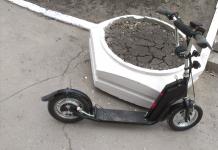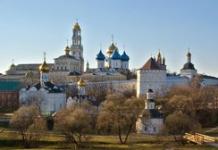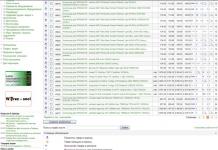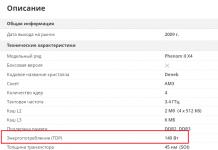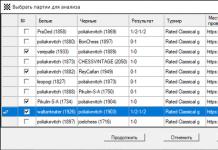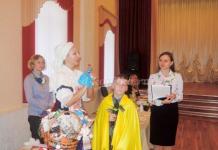standby time
Fig. 4. Dependence of the probability K of the inoperative state of the TSZL on the duty time τ; τ0 is the optimal value of τ at which the minimum possible probability of an inoperative state of the TSZL is reached.
It follows from Fig. 4 that the same value of K * is realized at different values of τ. More value is found to be economically viable, as maintenance needs to be carried out much less frequently.
4. Calculate the intensity of the requirements λt for the performance of the TSZL of the required functions (the intensity of the requirements to prevent the impact of RP on people). In each case, this number is justified taking into account the specific situation, in the general case, it is calculated by the formula (10):

where ΣN ps is the total number of people killed and injured in fires in similar objects over the previous year (or the average annual number over the last two to three years);
ΣN is the total nominal number of people in similar objects.
5. Calculate the probability P n that the TSZL during T = 1 year will be caught by a fire in an inoperative state and people will be affected by the OFP (fire risk).
If the TSZL is intended to rescue only one person (for example, an individual fire rope-lowering device), P n is calculated by the formula:
P n = λt T (K s + K i + K to); |
|
K c = ωc τ / 2; |
|
K i = ωy / μ; |
|
K then = t then / τ. |
Calculated by the formula (11) P n is compared with the normative (permissible) value of 10-6 (Federal Law No. 123 of 22.07.2008 "Technical regulations on fire safety requirements", Articles 79, 93).
If P n ≤ 10-6, the requirements of the Technical Regulations are observed, if P n> 10-6, this TSZL must be changed to TSZL of another type - more reliable, if P n<< 10-6 , надежность ТСЗЛ намного превышает надежность, требуемую данной ситуацией, а достижение этой надежности требует излишних капитальных и эксплуатационных расходов.
To reduce operating costs, it is necessary to increase the standby time τ (the more τ, the less frequent maintenance is carried out). For this purpose, using formula (12), two values of τ are determined, which will provide P n = 10-6. A larger value of τ allows ensuring the safety of people required by the Technical Regulations with minimal operating costs:
6. If the non-redundant TSZL is intended for simultaneous protection from the OFP on average N people around the clock during the year at the facility (for example, an automatic fire extinguishing installation in a medical pressure chamber), the calculation is made according to the inequality:

If the TSZL is duplicated (general reservation, reserve loaded), the calculation is performed according to inequality (14), which is derived for the case when the maintenance of the reserve and redundant TSZL is shifted in time so that during the maintenance of one TSZL the other is necessarily on duty:
Compliance with inequalities (13) and (14) means that the level of ensuring the safety of people is not lower than that required by the Technical Regulations. However, if the left sides of the inequalities are significantly less than the right ones, the reliability of the TSZL in this situation is excessive and unnecessary operating costs are spent on maintaining this reliability. These costs can be minimized as follows.
For an unreserved TSZL, as described in clause 5, two values of τ are calculated using formula (12). A greater value will ensure the safety of people required by the Technical Regulations with minimal operating costs.
For a duplicated TSZL (total reservation, reserve loaded), various values of τ are substituted into inequality (14), and by the method of successive approximation of the left side of the inequality to the right, the limiting value of τ is calculated at which the left side will not exceed the right.
If it is necessary to carry out calculations with an enumeration of a large number of variants of TSZL with different initial data (for example, when designing TSZL), the limiting value of τ can be calculated from equation (15):
where ![]() ;
;
This equation is solved with a PC using a standard program.
7. When protecting people at the facility with two, three or four TSZL of various types, for example, an automatic fire extinguishing installation (AUP), a smoke protection system (PDZ), a fire alarm system (SPS), a warning and evacuation control system in case of fire (SOUE) , the calculation is made as follows.
7.1. If all types of TSZL are structurally and functionally arranged as a single fire protection system (SDS) of the object so that the actuation (from-

kaz) of one TSZL, for example, AUP, leads to the operation (failure) of other TSZL, according to formulas (1-6), ωc, ωя of each type of TSZL is calculated.
7.2 Calculate ωc (SDR) and ωя (SDR) of a single fire protection system
where t in (i) is the average recovery time of the TSZL of the i-type; l is the number of types of TSZL.
In particular, if the object is equipped with four TSZL of various types, as indicated in clause 7:
7.5. If all types of TSZL are structurally and functionally autonomous, completely independent from each other technical means so that the failure of one TSZL does not affect the performance of other TSZL, according to the formulas(1-8,
11.1-11.3, 12) calculate K s, K i, K then each TSZL separately and the obtained values are summed up to determine K (AUP), K (PDZ), K (SOUE), K (ATP):
K (AUP) = K with (AUP) + K i (AUP) + K then (AUP); |
|
K (PDZ) = K s (PDZ) + K i (PDZ) + K then (PDZ); |
|
K (SOUE) = K s (SOUE) + K i (SOUE) + K to (SOUE); |
|
K (SPS) = K s (SPS) + K i (SPS) + K to (SPS). |
|
7.6. Calculate the probability that all four types of TSZL will be inoperative. |
|
capable of: |
|
K (4) = K (AUP) K (PDZ) K (SOUE) K (ATP). |
|
7.7. The obtained value of K (4) is compared, as described in clause 6, with the right-hand side |
|
inequalities (13): |
|
Calculation of radiation risk for personnel of emergency rescue teams
Permissible time T of work in a field with an effective radiation dose rate P, at which the permissible effective dose D for a person will not be exceeded (D ≤ 0.2Sv):
T = D / R. |
The minimum safe distance L from a local radiation source at which personnel can work for a time T:
L = l, (27)
where l is the distance at which the local radiation source creates the dose rate Р l.
The thickness of the screen d made of any material that must be placed between the local radiation source and people in order for the dose rate to
where 1.3 is the thickness of the half-attenuation layer for lead, cm; m is the number of layers of half radiation attenuation for the material
ρc, ρ - density of lead and screen material.
where P 0 is the radiation dose rate at the workplace before the installation of the screen; P 1 - permissible radiation dose rate at the workplace after
setting the screen.
The average number N 1 of people out of N people exposed to radiation who will fall ill with an incurable disease and die from it on average 15 years after irradiation:
where 0.0134 1 / year is the average risk of human death for 1 year (Russia, 2010, urban population, male gender, age 30-59 years).
Calculation of the likelihood of fires (Forecasting fires)
The probability P (N w) of a fire with the number of simultaneous victims N w up to 5 people inclusive during time t at an object (in a city, region, country) with a nominal population N is calculated by the formula:
where λ is the intensity of the flow of fires of a certain type (Table 1).
Table 1 Intensities of fire streams in Russia, averaged according to statistical data for
2009-2010
A stream of fires with a number |
Fire rate |
||||
simultaneous victims N w |
λ, 1 / person · year |
||||
(all fires) 0 or> |
N w0 + |
· 10 -6 |
λ 0+ |
||
N w1 + |
· 10 -6 |
λ 1+ |
|||
N w2 + |
· 10 -6 |
λ 2+ |
|||
N w3 + |
2.3 10-6 |
λ 3+ |
|||
N w4 + |
0.6 10-6 |
λ 4+ |
|||
N w5 + |
0.2 10-6 |
λ 5+ |
|||
The probability of a fire P (N w) with the number of simultaneous victims N w more than 5 people during time t at an object (in a city, region, country) with a nominal population N:
where N w - the number of simultaneous victims of a fire; λ 5+ - the intensity of the flow of fires with the number of simultaneous victims of 5 or more people; a, b, c - parameters of the distribution of the number of simultaneous victims in a fire of type N x5 + (a
14.81; b = 0.58; c = 5).
Averaged across the country and for all objects, the intensity of the flow of fires λ, indicated in table. 1, should be used in the case when there is no more

accurate data. Appendix 6 presents the updated fire rates, which are referred to as "fire frequency". The frequency of fire occurrence per establishment means (λ · N) by the formula (33). The frequency of occurrence of a fire per person means λ in the formula (33).
Calculating the economic equivalent of human life
The economic equivalent E (T w) of the life of an average person without difference in sex in middle age T w:
E (T g) = D s 2 / R y, |
where D with 2 - average per capita disposable cash annual income (average per capita cash income minus mandatory payments: taxes, rent, utilities and other financial obligations); Р у - background risk of human death (mortality rate taking into account all causes of death); T w - the average age of living people (in Russia in 2010 - 38.5 years);
The economic equivalent of E about the life of a newborn:
where a, b, c are the parameters of the probability distribution of the age of the animal.
leading people: for 2010 a = 43.31; b = 1.86; c = 0.
The economic equivalent of E (t W) of the average person at the age of t W:
PRACTICAL PART
Calculation of the reliability of technical means of protecting people from dangerous fire factors
Task 1. It is planned to equip a 16-storey hotel with N = 500 places from the second floor and above with individual rope-and-descent fire rescue devices. Funds allocated for operating costs allow the designation of a maintenance strategy that includes maintenance of devices with a frequency of at least τ = 0.5 years (standby time) with an average duration of maintenance t to = 8 hours = 0.000913 years. Previously m
= 100 devices of this type have been field tested for t i
= 2 years each, and during this time Σ n c = 12 latent and Σn i = 4 explicit failures. The average time to restore the operability (time to eliminate the malfunction) of the device was t in = 3 hours = 0.000342 years, the average time of the inoperative state for
the rank of obvious failures t i = 6 hours = 0.000685 years.
Calculate: 1. Individual fire risk P n in the hotel with the assigned strategy of maintenance of rescue devices;
2. The optimal value (standby time) at which the individual fire risk in the hotel reaches the minimum possible value of P nm;
3. Minimum and maximum valuesτ (standby time) at which the individual fire risk does not exceed the value allowed by the Technical Regulations;
4. The calculation results are presented in graphical and tabular form;
5. Make a conclusion about the possibility of reducing the individual fire risk in a hotel to an acceptable level by supplying each hotel guest with an individual fire rescue device, as well as the possibility of reducing operating costs by increasing the standby time τ over the task specified in the condition.
Solution. 1. Using formulas (1) and (2), we calculate the parameters of the flows of latent and explicit failures of the rescue device:
ω c = 12/100 2 = 0.06 1 / year; ω i = 4/100 2 = 0.02 1 / year.
2. Using the formula (7), we calculate the rate of restoration of the device operability (to restore the operable state of the device
start after some time delay due to administrative, logistic and technical reasons):
μ = 1 / 0.000685 = 1460 1 / year.
3. Let us calculate the intensity of requirements λ t to prevent the impact of GPP on a person (intensity of the required function). For this purpose, we will use Appendix 6. The frequency of fire in hotels is λ = 3.255 · 10-4 per one place. Taking into account the fact that there are N = 500 places in the hotel, we calculate by the formula (33) the probability P of a fire in the hotel for t = 1 year:
Not every fire is accompanied by loss of life. According to statistical data for 2010 in the Russian Federation, only 6% of fires were accompanied by the death of people (in most cases, one person). Then the probability P g of the death of people in the hotel in 1 year is equal to:
P g = 0.150196 0.06 = 0.009012,
and the probability Pr1 of the death of one individual person (individual fire risk):
P g1 = P g / N = 0.009012 / 500 = 0.000018.
The probability P g1 is the intensity of the requirements λt to prevent the impact of RP on a person (the intensity of the required function):
λt = P g1 = 0.000018.
4. According to the formula (11), we calculate the individual fire risk Р n for a person equipped with a rescue device (the probability that the rescue device will be caught in a fire in an inoperative state during T = 1 year and the person will be affected by RP):
R n = 0.000018 · 1 · (0.06 · 0.5 / 2 + 0.02 / 1460 + 0.000913 / 0.5) = 0.3 · 10 -6.
5. Using formula (8), we calculate the optimal time (standby time), when
torus, the probability of finding the rescue device inoperative will be the lowest possible under the given conditions:
= (2 0.000913 / 0.06) 0.5 = 0.174 years.
6. Using formula (11), we calculate the minimum possible individual fire risk P nm under the given conditions, substituting the obtained value instead of τ:
P nm = 0.000018 · 1 · (0.06 · 0.174 / 2 + 0.02 / 1460 + 0.000913 / 0.174) = 0.1 · 10-6
7. Using the formula (12), we calculate two values of τ at which the individual fire risk does not exceed the value allowed by the Technical Regulations:
τ1 = (81.09 - 79.64) / 87.6 = 0.017 years; τ2 = (81.09 + 79.64) / 87.6 = 1.83 years.
8. Substitute the obtained values τ 1, τ 2 into the formula (11) and calculate Р n:
P n (τ1) = 0.000018 · 1 · (0.06 · 0.017 / 2 + 0.02 / 1460 + 0.000913 / 0.017) = 10-6;
P n (τ2) = 0.000018 · 1 · (0.06 · 1.83 / 2 + 0.02 / 1460 + 0.000913 / 1.83) = 10 -6;
9. The results of the solution are presented in Table 2 and in Fig. 5
table 2 |
||
Results of solving problem 1 |
||
Operating costs |
||
standby time |
Fire risk Рн (10 - 6) |
(expenses for 1 are taken at |
τ = 1.83 years) |
||
Conclusion: 1. The individual fire risk in a hotel when it is supplied with individual fire-fighting rescue devices per person and with a maintenance strategy that provides for a standby time τ = 0.5 years, with an average duration of maintenance t to = 8 hours, is 0.3 10-6 (item 4 of the solution to the problem).
2. The optimal duty time at which the individual fire risk in the hotel reaches the minimum possible value P nm = 0.1 · 10-6 is = 0.174 years (clauses 5.6 of the solution).
III.3 Individual risk assessment
III.3.1 For the designed buildings (structures), the individual risk is initially assessed according to (III.2) at R e, equal to zero. If, in this case, the condition, then the safety of people in buildings (structures) is ensured at the required level by a fire prevention system. If this condition is not met, then the calculation of the individual risk Q in should be carried out according to the calculated dependencies given in section III.2.
III.3.2 It is allowed for an individual risk to be assessed by Q in in one or more rooms farthest from exits to the safe area (for example, the upper floors of multi-storey buildings).
III.4 Calculation of social risk
Social risk is assessed as the probability of 10 or more people dying as a result of a fire during a year. Calculations are carried out as follows.
III.4.1 Determine the probability Q 10 death of 10 or more people as a result of fire.
III.4.1.1 For industrial premises Q 10 calculated by the formula
 (Sh. 34)
(Sh. 34)
where M- the maximum possible number of deaths as a result of the fire, people.
![]() (Sh. 35)
(Sh. 35)
where N- number of employees in the room (building), people
III.4.1.2 For halls, the probability Q 10 deaths of 10 or more people are calculated by the formula
 (Ш.З6)
(Ш.З6)
where (Ш.37
III.4.2 The probability of death from a fire of 10 or more people during the year R 10 calculated by the formula
R 10 = Q p P pr (1 - R e ) (1 - R pz) Q 10 . (Sh.38)
III.4.3 For the operated building (structures), the calculated value of social risk may be checked finally using analytical data according to the formula
, (Sh. 39)
where N 10 - the number of fires that resulted in the death of 10 or more people during the observation period T, years:
N about - the number of observed objects.
Example -Assess the individual and social risk for people working in the machining workshop (hall).
Calculation data
In a machining shop measuring 104 x 72 x 16.2 m, an emergency oil spill and ignition occurred on an area of 420 m 2.
The workshop employs 80 people. on four mechanical sections in three shifts, P pr = 1. The workshop has two evacuation exits in the middle. The width of the central passage between the mechanical sections is 4 m, and the width of the passages between the equipment and the walls is 2 m, 20 people work in the sections. People are at zero. According to experimental data, the time required to establish a stationary oil burnout mode is 900 s. The combustion characteristics of oil, taken from the literature, are as follows:
net calorific value Q = 41.9 MJ / kg; smoke generating ability, D = 243 Np m 2 / kg; specific yield of carbon dioxide = 0.7 kg / kg; specific oxygen consumption = 0.282 kg / kg; specific massburnout rate y = 0.03 kg / (m 2 s).
Payment
The calculated evacuation scheme is shown in Figure III.2.

Fire place; I, II - emergency exits;
1, 2- sections of the evacuation route.
Figure III.2 - Design scheme of evacuation
Evacuation is carried out in the direction of the first evacuation exit, since the second is blocked by the fire.
The density of the flow of people in the first section of the evacuation route:
![]() m -2
m -2
Time of movement of the flow of people in the first section:
![]() min.
min.
Traffic intensity of the flow of people in the second section:
![]() m / min.
m / min.
The time of movement of the flow of people in the second section, since q 2 = 1< q max = 16,5:
![]() min.
min.
Estimated evacuation time:
t p = t 1 + t 2 = 0.88 + 0.52 = 1.4 minutes.
Geometric characteristics of the room:
h= 1.7 m; V = 0.8 104 72 16.2 = 94.044 m 3
When burning a liquid at an unsteady rate:
![]() ; at NS
=1,5.
; at NS
=1,5.
Determine t cr at x = 0.3 and E = 40 lux, B = 2 136 kg:
; l pr = 20 m;
elevated temperature
by loss of visibility:
for reduced oxygen content:

for the release of carbon dioxide
![]() =
min (362, 135) = 135 s.
=
min (362, 135) = 135 s.
Required time for evacuating people from the premises:
t nb = K b t cr = 0.8 x 135 = 108 s = 1.8 min.
From comparison t p with t nb is obtained:
t p = 1, 4< t нб = 1 , 8.
Probability of evacuation by evacuation routes:
R e.p = 0.999.
Evacuation probability:
R NS = 1 - (1 - (1 - R e.p) (1 - R d.v) = 1 - (1 - (1 - 0.999) (1 - 0) = 0.999.
Estimated individual risk:
Q in = Q n P p p (1 - R e) (1 - R p.z) = 0.2 · 1 (1 - 0.999) (1 - 0) = 2 · 10 -4;
Q in = 2 · 10 -4> = 10 -6.
That is, the condition for the safety of people is not met, the value of the individual risk is greater than the permissible one.
Let's assess the social risk in the area under consideration using the formula (III.36). Insofar as t p< t бл accept Q 10 = 0, therefore, the probability of 10 or more people dying as a result of a fire in the area under consideration is 0.
APPENDIX E
INDIVIDUAL RISK ASSESSMENT METHOD FOR OUTDOOR PROCESS INSTALLATIONS
E. 1 This method is applicable for calculating individual risk (hereinafter referred to as the risk) at outdoor technological installations in the event of such damaging factors as excessive pressure developed during the combustion of gas-vapor-air mixtures and thermal radiation.
E.2 Risk assessment is carried out on the basis of constructing a logical scheme, which takes into account various initiating events and possible options for their development. An example of building a logic diagram for a pressurized LPG storage tank is shown in Figure E.1.

Figure E. 1 - Logical diagram of the development of an accident associated with the release of combustible substances at outdoor installations
Symbols A 1 - a 10 denote:
A 1 - instant ignition of the outflowing product, followed by torch combustion;
A 2 - torch burning, the thermal effect of the torch leads to the destruction of the nearby reservoir and the formation of a "fireball";
A 3 - instant ejection of the product with the formation of a "fireball";
A 4 - instant ignition did not occur, the accident was localized due to effective fire prevention measures or due to dispersion of the vapor cloud;
A 5 - instant flash did not occur, fire prevention measures were unsuccessful, spill ignited;
A 7 - combustion of a cloud of a vapor-gas-air mixture;
A 9 - combustion of a cloud with the development of excess pressure in open space;
a 6 , a 8 , A 10 - destruction of a nearby reservoir under the influence of excessive pressure or heat during the burning of the strait or the formation of a "fireball".
The question of why the calculation of fire risk is necessary is always faced by the heads of the objects of protection (enterprises and organizations). Not everyone understands this indicator. Therefore, we will give it a precise definition. Fire risk is the possibility of a fire hazard for both people and material assets. It turns out that the calculation made is nothing more than an assessment of the impact on people of the dangers that await them during a fire. By the way, fire risks are legalized by the Federal Law of the Russian Federation No. 123 in Article 6, which clearly states that calculations are necessary for those facilities where there are deviations from regulations related to fire safety.
Let's start with the question of what the calculation of fire risk is for. There are several positions that justify certain parameters:
- the area of the object as a whole or its compartments and sections;
- solutions that are applied in terms of planning buildings and structures;
- optimal distances between objects are established;
- parameters of escape routes, as well as fire exits;
- installation site: stationary and mobile;
- placement of fire extinguishing means, determination of their number;
- technical solutions for signaling and warning devices;
- design and installation of automatic fire extinguishing systems.
In general, we must say that fire safety is a set of measures that determine risks. And there are many factors affecting fire safety. For example, the number of storeys of buildings, their layout, the purpose of this structure or each floor. Is there a warning system in the building and so on. That is, it turns out that the level of safety is determined by assessments of fire risks.
And the calculation of fire safety risks is an event, or rather a process in which an analysis of the negative impact on people is carried out. The purpose of the calculation is to show how strongly the fire will affect people. And accordingly, how can you reduce (reduce) these factors.
At the same time, after calculating fire risks, the manager of the facility can accurately justify the parameters of the facility from the above list. The calculation itself is carried out for two types of objects: public and industrial. We add that all the standards are precisely specified in Federal Law No. 123: for production in article 93, for public in article 79.

For production
What is specified in the law. Let's designate the main positions:
- The indicator of fire risk (individual) should not exceed one millionth per year. This applies to industrial buildings.
- If people are in administration buildings, canteens and others, that is, not in the production itself, then the risk is no more than one hundred millionth share.
Let us immediately indicate that there are two types of risks: individual and permissible. The first is fire risk, which leads to human death in the course of fires. Tolerable fire risk is a reasonable and acceptable value taken from socio-economic conditions.
For public
Article 79 has two points:
- Determines the individual fire risk, taking into account that in the event of a fire, a person will be at the farthest point from the source of fire. Here the parameter is one ppm.
- The risk of human death should be determined taking into account the functioning of the fire extinguishing, alarm and warning system.
We add that there is one more type of risk - social. It concerns people who live in residential buildings near industrial or public facilities. They are also in danger if buildings and structures are on fire. Here the risks of fire hazard do not exceed one hundred millionth share. That is, one person per one hundred million people may die. This is what determines the fire risk.
It should be noted that the permissible fire risks are a hypothetical value. In essence, it is a balance between the cost of providing fire safety with the damage from a fire.

Calculation example
What parameters need to be collected to determine the assessment of the fire risk of buildings and structures:
- the volume of the building, its area and planning solutions;
- indicators of thermal resistance of materials from which the bearing and enclosing structures of buildings are assembled;
- the number of equipment with heat engineering characteristics, the plan of their placement;
- characteristics of auxiliary premises, focusing on warehouses where flammable and explosive substances are stored;
- how are automatic fire extinguishing systems installed, whether they comply with regulatory enactments;
- whether there is a smoke protection, alarm and warning system available.
All this data will help determine the real fire situation. But it will not be one hundred percent real, if you do not take into account external factors:
- how the fire will develop, in which direction it will move;
- how quickly the protective fire protection systems will work;
- how people react to the alarm, they will take it responsibly, having competently evacuated and participating in extinguishing the initial stage of the fire.

The definition of fire risk should be approached from the standpoint of developing probable scenarios for the development of a fire. For example, the exact definition of the source of fire. How the fire will behave, identify a high probability in which direction it will develop. It is important. Having determined the direction, we can say with a high probability that a spreading fire can be found in a certain area, extinguishing it at the root. And for this you need to know the layout of buildings, the location and the number of narrow passages and other architectural structures.
After all, fire spreads according to certain laws. It just doesn't move in some direction. The fewer obstacles there are, the higher the likelihood that the fire will develop in that direction. Of course, one must take into account the type of materials from which the enclosing and supporting structures of buildings are erected in each direction.
Do not forget that each building structure has its own temperature limit. If we add the direction of fire propagation to this criterion, then we can talk with a high degree of accuracy about where it is best to locate the fire extinguishing means. By the way, the calculation of risk must take this parameter into account as one of the main indicators.
And the last stage. After the calculation, an assessment is made. She must reveal - Does the submitted project comply with the real conditions and norms?.

Nuances of calculation
It should be noted that the heat engineering parameters of protective structures are one of the main criteria for the correct calculation of fire risks. A layman cannot understand this. If the risks to the projected building are determined, then all these indicators are in the project. If the calculation of risks is carried out for an operated building, then you will have to look for some indicators in GOST SNiPs. Although today many characteristics of building materials are freely available on the Internet. Let's designate some of them in the table.
Let's make a reservation right away that fire sources are not taken into account in fire risk calculations... It makes no difference whether the object was set on fire, or it caught fire on its own from some man-made reason. The only thing that needs to be identified is the scenario of the fire development. Here we have to consider the facts that are directly related to the functioning of buildings or structures. For example, if this is a factory, then there is a high probability that a fire will start from a short circuit or ignition of flammable liquids or gases.
One of the key parameters used in calculating fire risk is the frequency of occurrence of fire hazardous situations or the frequency of occurrence of a fire in a building during the year.
As a matter of fact, they became "frequencies" in 2006, with the release of the Guidelines for the assessment of fire risk for industrial enterprises. And after the entry into force of the Technical Regulations on Fire Safety Requirements, the Rules for Calculating Fire Risk Assessment and the Methods adopted in their development, this term finally entered into circulation. And before that, in GOST 12.1.004-91, GOST R 12.3.047-98 and a number of other documents, the concept "" was used.
In this article, I will use the terms listed above without making any special distinctions between them.
As I said above, the probability of a fire is necessary to determine the calculated values of fire risk in accordance with the Methods, the level of ensuring fire safety of people in accordance with Appendix 2 to GOST 12.1.004-91 *, individual and social risk for industrial buildings in accordance with Appendix Ш GOST 12.3.047-98. It is obvious.
Also, the likelihood of a fire can be used to assess the economic efficiency of fire safety systems and a feasibility study for fire-prevention measures according to the methods set forth in Appendix 4 GOST 12.1.004-91 *, MDS 21-3.2001 and Appendix 1 to MDS 21-1.98. This is a less obvious way of using the desired variable and is practically not used in practice.
So, for a number of design justifications in the field of fire safety, the probability of a fire has been used for more than twenty years. Only now there is still very little data on it. These data are scattered and often contradictory. In this post, I tried to piece them together from various sources that I managed to find all existing domestic sources.
To start from the end or from the beginning?
Perhaps ... I'll start, perhaps, in order.
GOST 12.1.004-91 * - the earliest of the documents under consideration, provides a method for determining the probability of a fire (explosion) in a fire hazardous facility (Appendix 3). Also, in one of the examples given in Appendix 6 to the specified GOST, without any explanation or reasoning, the statistical probability of a fire in buildings is indicated hotels- 4 × 10 -4.
Note: Appendix 3 GOST 12.1.004-91 * can be applied on a voluntary basis to comply with the requirements of the Technical Regulations on fire safety requirements, in accordance with the List [12 ].
A slightly different approach to determining the likelihood of a fire was proposed by MGSN 4.04-94, followed by MGSN 4.16-98. In accordance with these Moscow city building codes, the likelihood of a fire in hotels and multifunctional buildings should be taken depending on the presence of a preventive fire brigade (PSPO) or other permanent fire safety service at the facility, and also taking into account the distance from the facility to the nearest fire brigade (fire station):
For hotels, it was also allowed to determine the probability of a fire on the basis of statistical data: on the number of fires in hotel buildings per year (according to VNIIPO) and the number of hotel buildings in the Russian Federation (according to the State Statistics Committee).
Note: Attention! The probability is indicated per 1 m 2 of the area of the room.
In 1998, MDS 21.1.98 was released, in Appendix 3 of which examples of a feasibility study of fire-prevention measures are given. In these examples, also without any explanations and references to sources, data on the likelihood of fires at some objects are given:
|
Object type |
The likelihood of a fire , m 2 / year |
MDS 21-3.2001, released three years later, recommended determining the probability of a fire according to statistical data or according to Appendix 3 to GOST 12.1.004-91 *. The calculation examples also provide data for some types of objects:
|
Object type |
The likelihood of a fire , m 2 / year |
| Warehouse building | |
| Parking lot for cars | |
| Warehouse for multi-product products | |
| Administrative building | |
| Administrative building of a manufacturing enterprise | |
| Industrial building | |
| Paint shop | |
| Industrial building of a trucking company | |
| Industrial building of the electrical equipment plant | |
| Extraction workshop for oil extraction production | |
| Shopping center | |
| Consumer services building |
Note: Data on the likelihood of a fire are given per 1 m 2 of the building area.
Where did this data come from? Can you trust them and use them in calculations? This is completely incomprehensible. But we can definitely say that the data on the probabilities of fire given in MDS 21-3.2001 are, on average, an order of magnitude lower than those indicated in GOST R 12.3.047-98.
Five years later, the Fire Risk Assessment Guidelines for Industrial Enterprises duplicated the data previously published in GOST R 12.3.047-98, and also provided information on two types of objects that were absent in GOST:
|
Object name |
Fire frequency, m 2 / year |
| Power plants | |
| Chemical warehouses |
1,2∙10 -5 |
| Warehouses for diversified products |
9,0∙10 -5 |
| Tool-mechanical shops | |
| Workshops for the processing of synthetic rubber and artificial fibers | |
| Foundry and smelting shops | |
| Workshops for processing meat and fish products | |
| Workshops for hot rolling of metals | |
| Textile production |
Notes:
- Data on the likelihood of a fire are given per 1 m 2 of the building area;
- “New” objects are highlighted in red.
Interestingly:
- both in GOST and in the Manual errors were made in the dimension of probability (frequency);
- data on the likelihood of fires in warehouses of multi-product products are given in MDS 21-3.2001 and in the Manual. They differ in ten once!
And in 2009, the modern stage came, with its calculations of fire risks, calculation Methods and new data on the "frequency of fire in buildings during the year."
The simplest situation was with information on the frequency of fires in industrial and warehouse buildings, which are given in Appendix No. 1 to the Methodology for determining the calculated values of fire risk at industrial facilities. They are exactly the same as the data of the Guidelines for the assessment of fire risk for industrial enterprises and, with the exception of two types of buildings, the data of GOST R 12.3.047-98. And I will not duplicate them again in this article.
Well, in fairness, it must be said that the Methodology allows obtaining information about the frequencies of the implementation of fire hazardous situations from data on the functioning of the object under study or from data on the functioning of other similar objects.
With the Methodology for determining the calculated values of fire risk in buildings, structures and structures of various classes of functional fire hazard, everything was much more complicated and interesting. Initially, it allowed several ways to obtain information about the frequency of a fire in a building over the course of a year:
- according to the data given in Appendix No. 1 to the Methodology;
- according to data published in the scientific and technical journal "Fire Safety";
- in the absence of data, it was allowed to take the frequency of fire occurrence equal to 4 × 10 -2 per year for each building.
Moreover, in Appendix No. 1 to the Methodology, information was provided for the "updated assessment" of the frequency of fire occurrence and for its assessment "per institution". If data were available on the number of people in a building, it was ordered to use an updated estimate, and only if they were not available, an estimate per institution.
Here are these statistics. I am citing for history, due to the fact that changes have already been made to them:
|
Building name |
Fire frequency throughout the year |
||
|
Per institution |
Revised estimate |
||
| Preschool institutions (kindergarten, nursery, orphanage) |
(per child) |
||
| General educational institutions (school, boarding school, orphanage, lyceum, gymnasium, college) | |||
| Primary vocational education institutions (vocational technical school) |
(per student) |
||
| Institutions of secondary vocational education (secondary specialized educational institution) |
(per student) |
||
| Institutions of higher professional education (higher educational institution) |
(per student) |
||
| Other out-of-school and childcare institutions |
(per student) |
||
| Children's health camps, summer children's cottages |
(per one vacationer) |
||
| Hospitals, hospitals, clinics, maternity hospitals, psycho-neurological boarding schools and other hospitals | |||
| Sanatoriums, rest homes, dispensaries, homes for the elderly and disabled |
(per bed) |
||
| Outpatient clinics, clinics, dispensaries, first-aid posts, consultations |
(per patient visit) |
||
| Retail enterprises: department stores, department stores; supermarkets, grocery stores; mixed goods stores; pharmacies, pharmacy stalls; other trade buildings | |||
| Market trade enterprises: covered, wholesale markets (from buildings of stationary buildings), trade pavilions, kiosks, stalls, tents, containers |
(per employee) |
||
| Catering establishments |
(per employee) |
||
| Hotels, motels |
(per seat) |
||
| Athletic facilities | |||
| Club and cultural and entertainment establishments | |||
| Libraries | |||
| Museums | |||
| Entertainment institutions (theaters, circuses) |
(per visit by the viewer) |
||
Have you noticed that the data for the refined estimate is somehow strange? Previously, the probability of a fire per unit area of the object was given as a refined estimate. This approach to determining the likelihood of fire is used throughout the world. And here: per child, per student, per vacationer, per worker, per visit (viewer, patient), etc. For example, I didn’t immediately grasp what was meant by "being visited by a spectator" and "being visited by a patient." And now - I know it for sure.
Do you know why there were such strange parameters for a refined estimate?
And I know. And I will definitely tell you. A little bit later.
Now I propose to pay attention to sending us to the scientific and technical journal "Fire Safety". Indeed, statistical information on fires has been and is being published there, incl. data on the number of fires that occurred at various types of facilities:
- residential sector,
- vehicles;
- public buildings;
- industrial buildings;
- warehouse and retail space;
- under construction (reconstructed) objects;
- other buildings and structures, open areas;
- agricultural facilities.
This is not information about the frequency of fires in buildings. And even - not the information that can be used to obtain this "frequency".
What is the residential sector? These are buildings of two classes of functional fire hazard. Moreover, the number of fires in private residential buildings and in apartment buildings very much is different. And public buildings include objects sixteen! classes of functional fire hazard. And how did you manage to dump warehouse and retail premises into one heap? No, you can no longer work with this information.
However, this article was not completely useless (I paid 220 rubles for it). It lists the sources from which these miraculous data on the frequency of fires for public buildings were obtained. It:
- Russian statistical yearbook. 2005: stat. Sat. / Rosstat. M., 2006.819 p .;
- Federal data bank "Fires" for 2004
That is, at the time of publication of the article, this data was already more than four years old. They already smell like rotten. In our country, the number of fires is annually and steadily decreasing!
Now I want to return to "4 × 10 -2" - the value of the frequency of fire occurrence, which can be accepted in the absence of other data.
This value applies mainly to public buildings for administrative purposes and office buildings. And more recently - also parking lots. It's not a secret for anyone that this is due to the lack of our beloved VNIIPO (and in general - in nature) the necessary data on the number of such objects.
There is nothing more to talk about, I just want to compare this value with other data on the probabilities and frequencies of fires. And I will compare.
First of all, it must be said that 4 × 10 -2 does not stand out from the general series of data on the frequency of fires at other types of objects (per institution). And it slightly exceeds most frequencies for other types of objects. With the exception of higher educational institutions and entertainment institutions - they, apparently, burn more often in our country.
According to the data of MDS 21.1.98 and MDS 21-3.2001, 4 × 10 -2 is the probability of a fire in an administrative building or an administrative building of an industrial enterprise with an area of 8,000 m 2. Or in a parking lot for cars with an area of 4 250 m 2. And here everything lends itself to a reasonable explanation: buildings of this size are considered large, but they are found; the necessary safety margin is provided.
That is, we can say that this value corresponds to common sense and is verified.
Here I would finish my story, but they were included in the Methodology for determining the calculated values of fire risk in buildings, structures and structures of various classes of functional fire hazard. They also touched upon the frequencies of fire in buildings, and the procedure for determining them:
- firstly, we removed the data on preschool institutions. Not because they were wrong. But simply because the Methodology has ceased to apply to such objects;
- secondly, the revised assessment was removed - the one that should have been guided in the first place (where is the logic?). The one whose approach is fundamentally different from that accepted all over the world (changed your mind?);
Here, in short, that's all. Wow short!
Has anyone read this place?
Well then, express your opinion in the comments:
- firstly, it is interesting to me;
- secondly, I want to know such persistent in person. And how many there are - I would also like to know.
P.S .: The technique, one that does not allow the use of other data, except from Appendix No. 1 and "4 × 10 -2". But this does not mean that they do not exist.
They are!
And I will tell you about them. Soon.
Continuation of this article will be. And also an overview of "alternative" sources of data on the frequency of fire.
References:
- Rules for calculating fire risk assessment. Approved by Decree of the Government of the Russian Federation No. 272 dated March 31, 2009.
- Methodology for determining the calculated values of fire risk at production facilities. Approved by the order of the Ministry of Emergency Situations of Russia dated 10.07.2009. No. 404.
- GOST 12.1.004-91 "Occupational Safety Standards. Fire safety. General requirements".
- GOST R 12.3.047-98 "Occupational safety standards. Fire safety of technological processes. General requirements. Control methods".
- Fire Risk Assessment Guidelines for Industrial Plants. Moscow: VNIIPO, 2006 (approved by FGU VNIIPO EMERCOM of the Russian Federation on 03/17/2006; approved by the UGPN EMERCOM of the Russian Federation (letter dated 03.02.2006, No. 19/2/318)).
- MDS 21-1.98 "Prevention of the spread of fire". Manual to SNiP 21-01-97 "Fire safety of buildings and structures."
- MDS 21-3.2001 "Methodology and examples of the feasibility study of fire-prevention measures." To SNiP 21-01-97 *.
- MGSN 4.04-94 "Multifunctional buildings and complexes".
- MGSN 4.16-98 "Hotels".
- The list of national standards and sets of rules, as a result of which, on a voluntary basis, compliance with the requirements of the Federal Law "Technical Regulations on Fire Safety Requirements" is ensured. Approved by order of Rosstandart dated April 30, 2009 No. 1573.



